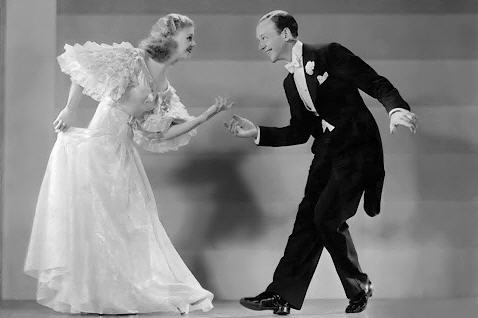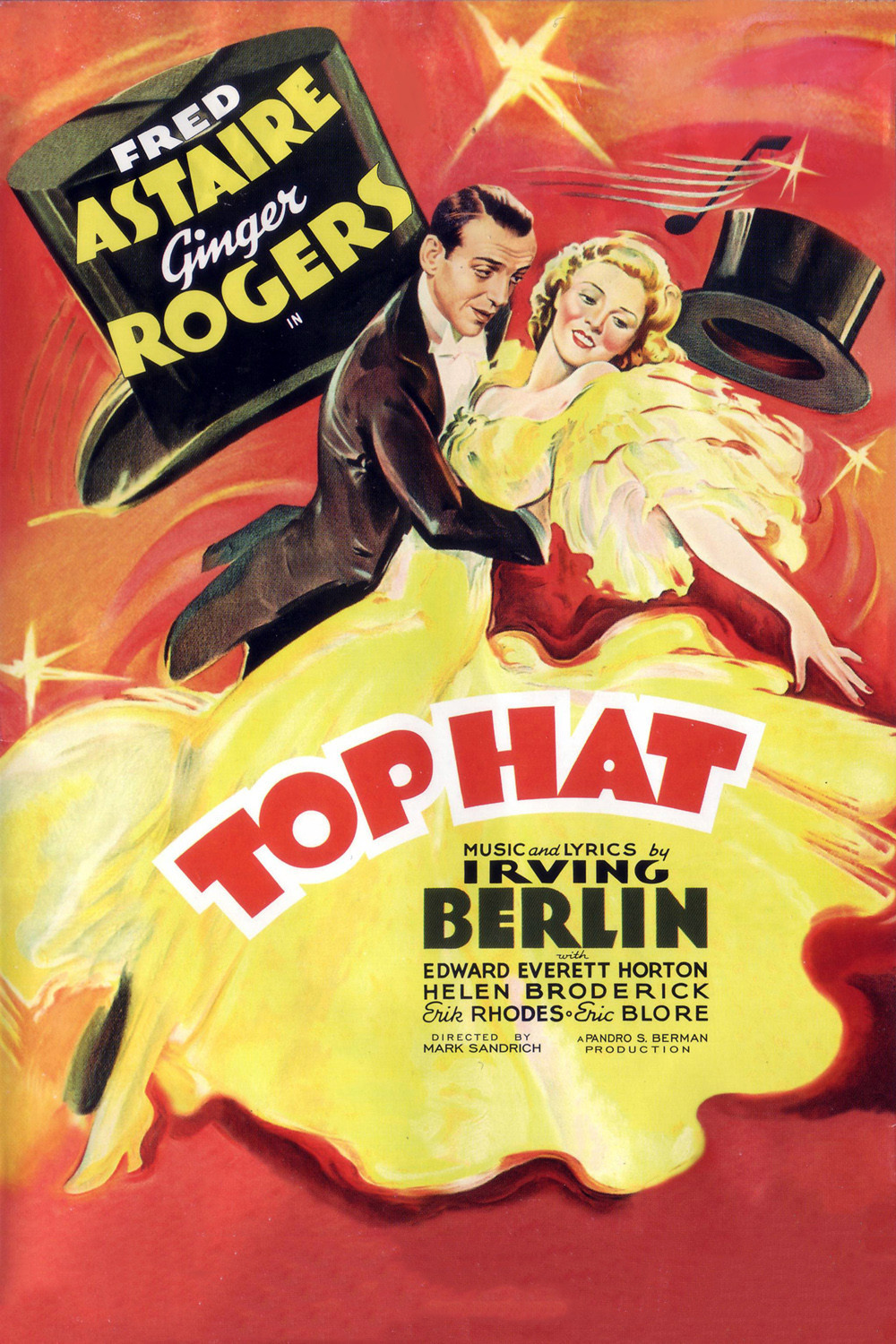
There are two numbers in “Top Hat” where the dancing on the screen reaches such perfection as is attainable. They are by Fred Astaire and Ginger Rogers for “Isn’t This a Lovely Day?” and “Cheek to Cheek.” Because Astaire believed that movie dance numbers should be shot in unbroken takes that ran as long as possible, what they perform is an achievement in endurance as well as artistry. At a point when many dancers would be gasping for breath, Astaire and Rogers are smiling easily, heedlessly. To watch them is to see hard work elevated to effortless joy: The work of two dancers who know they can do no better than this, and that no one else can do as well.
The movie has three other dance numbers, two solos by Astaire that are wonderful but not transcendent, and a final duet with Rogers (“The Piccolino”), where one of Irving Berlin’s lesser songs is redeemed by the sight of Astaire and Rogers dancing all over a huge set that is intended to represent a canal-side hotel in Venice and looks every bit as realistic as the Grand Canal Shoppes at the Venetian in Las Vegas.
The movie’s plot depends on a misunderstanding that is all but impossible: Ginger falls in love with Fred, then mistakenly decides he is the cheating husband of her best friend, Madge. “How is it that Ginger has never met her best friend’s husband?” Alan Vanneman reasonably asks in the Bright Lights Film Journal. “Well, Europe is a big place.”
Yes, and Madge and her husband, Horace, spend long periods living separate lives of luxury. That Horace is a womanizer seems, strangely, to cheer Madge, perhaps because none of the sex in this movie seems to require body parts. That’s why she gives her blessing to what Ginger thinks is adultery. She even pushes the couple onto the dance floor for the “Cheek to Cheek” number.
This is an Idiot Plot, yes, and could be cleared up at any moment by one line of sensible dialogue, but there are times when nothing but an Idiot Plot will do, and we are happy to play along. The movie, made during the Depression in 1935, features characters so rich that even their butlers are gentlemen of leisure. Astaire plays Jerry Travers, who is opening in a London musical being produced by his best friend, Horace Hardwick (Edward Everett Horton), which means he doesn’t know his best friend’s wife, either.
For reasons utterly contrived, Jerry is staying in Horace’s hotel suite, which is why Dale Tremont (Rogers) finds Astaire when she rings Horace’s doorbell. As the film opens, Horace advises Jerry on the pleasures of marriage, and Astaire insists on the joys of bachelorhood with “No Strings,” a Berlin song with lyrics that could have been written by the naughty Cole Porter:
Bring on the big attraction My decks are cleared for action I’m fancy free and free for anything fancy.
His tap-dancing during this number disturbs Dale, who is sleeping directly below them in a bedroom that looks like where Botticelli’s Venus spends her nights when the clamshell gets damp. She comes upstairs to complain, he falls in love, and the next day buys out the hotel flower shop to fill her room. “I wonder what Mr. Beddini is going to say about this,” the shop owner muses to an unbilled Lucille Ball. “The desk clerk has intimated that Mr. Beddini provides Miss Tremont with all the niceties, including her clothes. And her niceties are very nice.”
Alberto Beddini, who often speaks of himself in the third person, is played by Erik Rhodes as a dress designer who pays Dale’s expenses in return for her showing off his gowns at fancy watering holes. That he is gay goes without saying, and in 1935, it did. At one point, fed up with Dale, he declares, “Never again will I allow women to wear my dresses.”
Jerry and Dale meet in the hotel lobby, where she’s on her way to riding lessons. He pursues her to the park, where her ride is interrupted by a sudden shower. She takes refuge in a pavilion where he finds her, and as the rain pours all around them, he sings “Isn’t This a Lovely Day?” She tries to remain aloof, but when he begins to dance she begins, reluctantly at first, to join him.
When discussions come up about which of the two was the better dancer, people often quote a line that became famous after a 1982 Frank and Ernest comic strip: “Ginger Rogers did everything Fred did, and she did it backwards and in high heels.” Although she is wearing riding boots and not heels in this scene, what is remarkable is how supremely the two dancers work together. The dance begins as a solo by Astaire and then becomes a conversation in dance, each one performing a dazzling step which the other reproduces, until they are in perfect synchronicity. After watching this scene, there is only one thing to be done, and that is to watch it again.
Dale is now in love with this man, whoever he is. Then a hotel clerk points out “Mr. Hardwick” on the mezzanine, she thinks he’s pointing to Jerry, and is furious to have been romanced by a married man. She confesses all to Madge (played by Helen Broderick, who was the mother of Broderick Crawford, and we can believe it). But Madge is elated by the news, the latest in a series of dalliances by Horace that result in payoffs of diamonds and furs for her. Horace, who doesn’t know about the mistaken identity, thinks Jerry and Dale are simply having an affair, and assigns his butler Bates (Eric Blore, an ingratiating busybody) to shadow them and keep Jerry out of trouble before his show’s big opening night. Astaire arrives late at the theater, just in time for his “Top Hat, White Tie and Tails” dance number, which provided his signature song.
And why am I bothering to describe this plot, which exists as such silly froth it makes P.G. Wodehouse look ponderous by comparison? Perhaps because the actors give it such goofy playfulness. Events conspire to transport all of the principals to Venice, created on a gigantic Venetian set where gondolas travel for yards at a time and seaplanes land at restaurants. It was here that Madge intended to introduce them; she still doesn’t know they’ve met under Dale’s impression that Jerry is Horace. I love writing sentences like that. “You two run along and dance,” Madge tells them, “and don’t give me another thought.” That’s when Dale decides, “If Madge doesn’t care, I certainly don’t.” Jerry replies, “Neither do I. All I know is …”
Heaven, I’m in Heaven … And my heart beats so that I can hardly speak …
And then comes their third great dance number, covering most of the visible real estate in Venice and conveniently clearing a dance floor for theirpas de deux. This is the number featuring Rogers’ famous gown made mostly of ostrich feathers, which Astaire hated because they distracted from the clean lines of the dance (in “Swing Time,” one of her beaded costumes actually swipes him in the face). The feathers are a challenge for Rogers, too, who has to work with and not against them. Her choreography causes them to undulate as if she herself is almost in flight; at the moments when, in Astaire’s arms, she bends over backward almost to the floor, they underline the appearance of surrender.
Because we are human, because we are bound by gravity and the limitations of our bodies, because we live in a world where the news is often bad and the prospects disturbing, there is a need for another world somewhere, a world where Fred Astaire and Ginger Rogers live. Where everyone is a millionaire and hotel suites are the size of ballrooms and everything is creased, combed, brushed, shined, polished, powdered and expensive. Where you seem to find the happiness you seek, when you’re out together dancing cheek to cheek. It doesn’t even matter if you really find it, as long as you seem to find it, because appearances are everything in this world, and …
Let the rain pitter patter But it really doesn’t matter If the skies are gray. Long as I can be with you, It’s a lovely day.
Song lyrics © Estate of Irving Berlin. Also in Ebert’s “Great Movies” collection: Astaire and Rogers in “Swing Time” and Astaire and Cyd Charisse in “The Band Wagon.”




















